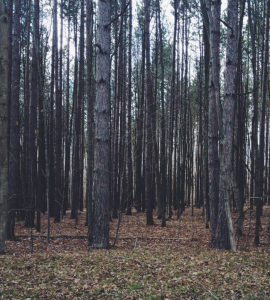“And he shall be like a tree planted by the rivers of water, that bringeth forth his fruit in his season; his leaf also shall not wither; and whatsoever he doeth shall prosper.” This verse from Psalm 1 is what opened the report on Forestry Management. This quote encapsulates what the committee is trying to do in regards to maintaining Christian stewardship of the land surrounding Houghton under their responsibility. The committee, an ad-hoc group made up of sustainability coordinator, Brian Webb; professor of biology, James Wolfe; director of technology services, Don Haingray; and vice president for finance and planning, David Smith, who have put their expertise together in order to protect the environment surrounding the college. The forest is well-used by students and faculty for bonfires, nature walks, and exercise on the many trails. From an outside perspective, one might never know there were any problems with the way the forest is growing.
 Essentially, the forest has become overcrowded. The trees are now so tightly packed not enough sunlight is reaching the forest floor, meaning there is very little undergrowth or new trees growing. This is unhealthy for the forest because in ten or twenty years when the older trees die, there will be no young trees growing to take their place.
Essentially, the forest has become overcrowded. The trees are now so tightly packed not enough sunlight is reaching the forest floor, meaning there is very little undergrowth or new trees growing. This is unhealthy for the forest because in ten or twenty years when the older trees die, there will be no young trees growing to take their place.
According to Webb, it has not always been this way. “If you look at pictures of Houghton’s early history you see blank, empty land,” he said. “Because all the trees were cut, and when a forest is that extensively cut, the way things regrow tends to be very artificial. We have an even age forest because they were all planted at the same time. It’s a product of the way humans cut the Houghton forest 100, 150 years ago.” The natural ecology of the forest has been disrupted, and the Forestry Committee is attempting taking the steps to help reduce the damage.
The committee’s focus is primarily on the overall health of the forest. Many of these necessary improvements can be made through a sustainable harvest plan. They developed a plan to thin out some of the trees in order to provide room for new trees to grow, in addition to providing the already existing trees with more space to grow healthily. Selective cutting, when done properly, will benefit the forest significantly, it will allow more light to reach the forest floor and help the smaller, younger trees to be healthy. The college will also benefit by selling the timber they cut down, with the revenue they receive going back into improving the forest environment.
In order to carry out this plan of safe timber removal, the committee has hired a New York State Forester. Already, he has done a detailed assessment of the forest, creating a specific breakdown of the different types of trees growing, which ones are growing well, and which are not, as well as gathering information on invasive species. The forester will mark the trees to be harvested, manage the timber company throughout the process, and ensure the entire logging process creates as minimal a disruption to the environment as possible.
The forester also identified ways to minimize the negative effects of tree removal, including minimizing the erosion caused by loggers, improving wildlife habitats, and dealing with invasive species. They will also avoid disturbing the everyday use of Houghton College property.
Though no date has yet been set for the timber removal to begin, it will take place either in winter or in summer. During winter, the ground will be frozen hard, which minimizes the damage vehicles can do to the forest floor. During summer, however, there will be few students still on campus, and will minimize the disturbance the logging process will make.
“This is a long term plan to care for this part of God’s creation. There is no ‘quick fix’,” said Smith.
Smith also said once the suitable harvest plan is set in motion, it will still take many years for the forest to return to its original healthy ecology. It won’t happen all at once. The plan recommended by the forester will take place over the next fifteen years, the first five years spent as they mark, harvest, and observe the changes to various parts of the forest. They will then spend ten years letting nature take its natural course and carefully observing what further changes may need to be made. It will likely take many generations of careful forest management before the forest is able to “take over on its own, and produce as it should,” as Brian Webb noted.
